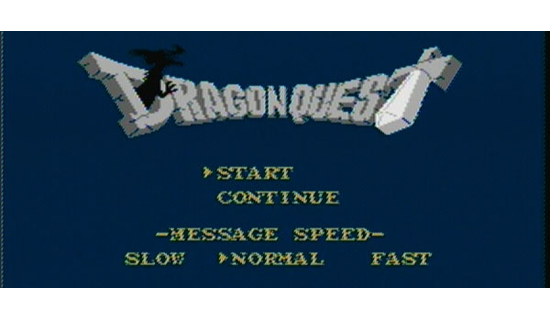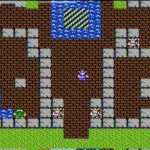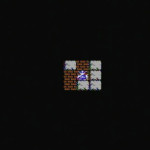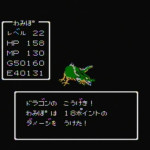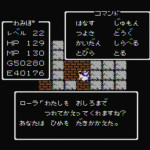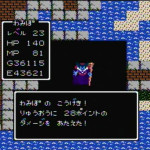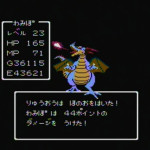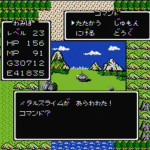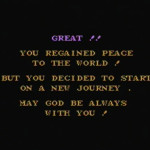When you look at the immense popularity of Dragon Quest in Japan these days, it’s hard to believe that it came from anything but itself. It’s often credited as the first and most influential Japanese RPG. While it’s certainly one of the most influential, it’s not the first. It owes its design to a handful of different predecessors, many of which are western and were released on home computers. Dragon Quest can lay claim to being the first turn-based console RPG (the first non-turn-based console RPG being Hydlide) though.
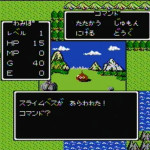 |  |
| The first enemy I encountered coming out of the castle, a good old Red Slime! | And here is the irresistible Dracky, showing that a lot of the enemy designs were actually pretty cutesy. |
The Ultima and Wizardy series were both brought to Japan on various home computers, and did reasonably well. Dragon Quest owes more to these two series than any others: It borrowed overhead travel throughout a world map, the use of experience points to level up, towns being hubs for everything you need (equipment and healing), and having separate battle screens all from the Ultima series. Then it borrowed Wizardry’s interactive battle menus. And though Japan had some of its own computer RPGs: Dragon Slayer and Xanadu from Nihon Falcom, along with the aforementioned Hydlide from T&E Soft (all of which were action RPGs), it’s clear that most of the influences on Dragon Quest came from the west. And qualities were taken from those western RPGs and improved upon in a way that greatly benefited a console game: They were made more simple. Since Dragon Quest was designed for a console audience (though it would see ports to various Japanese home computers later in 1986) it made a lot more sense to hide the more “hardcore” and confusing bits, like screens full of stats.
You can’t talk about Dragon Quest without mentioning the people behind it. It’s probably one of the earliest examples of a game with a “star-studded cast”, 2/3 of them being already known for things not directly related to gaming. Yuji Horii was the gaming personality (and the least well known) of the group, having designed Portopia Satsujin Jiken (The Portopia Serial Murder Case): A western influenced point-and-click adventure game (though its original version was not point-and-click, but rather text-parsed). Portopia was released in 1983 for the NEC PC-6001 home computer, which he later worked with Chunsoft to port to the Famicom and various other Japanese computers in 1986.
Akira Toriyama may be the most well known of the group, mostly for his work as a manga artist/writer. His breakout hit was Dr. Slump, serialized in the popular weekly manga magazine Shounen Jump from 1980 to 1984. At the time of Dragon Quest’s development and release, Toriyama was riding high on the enormous success of his flagship work Dragon Ball (which would not end until 1995). The immediately recognizable character design that you’ll find on the box and in the manual were all Toriyama, but the Famicom was much too primitive to support art that looked much of anything like his designs in the actual game. That didn’t stop his contributions from being a major part of Dragon Quest’s success though.
Last but not least is Koichi Sugiyama, a classically trained composer who was best known for writing music for commercials, animated films and TV shows (Gatchaman), musicals, and popular music in general. The story of him getting involved with Enix goes that he wrote a letter to them regarding a computer shogi game earlier in the 1980s. Enix was extremely surprised to receive a letter from someone of so much note, but that didn’t stop them from asking him if he would compose music for their games. He began his game composing career on the PC-8801 and went from there. Since he was a classically trained musician, he was able to write more complex and appealing game music than your average composer (just listen to the Dragon Quest theme song!), and also to later participate in the recording and conducting of the many Dragon Quest symphonic suites. He has since served as an inspiration to many other game composers.
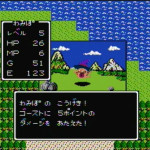 | 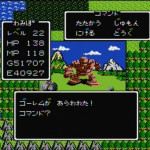 |
| More character design showcasing the cutesy side of things: a Ghost! | And the ever popular Golem, who has even crossed over into Final Fantasy XIV at this point. |
One big advantage that Dragon Quest had in regards to its marketing, was the involvement of both Horii and Toriyama: They both had connections to Shounen Jump. Toriyama had Dragon Ball currently serialized in Jump. Horii was freelancing with Jump at the time, with a video game column that would eventually become “Famicom Shinken”. Not only was it video game coverage in a magazine before there were dedicated publications for games (this was before Famitsu magazine), but it was also named from another hot Jump property Hokuto no Ken (Fist of the North Star) (specifically from the main character Kenshiro’s martial arts style, Hokuto Shinken). It featured drawings of characters dressed in costumes from the series, and scored games on the nontraditional scale of number of “atatatatata”s (Kenshiro’s Bruce Lee-esque battle cry heard as he executed Hokuto Hyakuretsu Ken on his enemies). In fact Jump played a very significant role in the formation of the game itself.
The idea to make a role playing game written by Horii and with art by Toriyama came from Kazuhiko Torishima: An editor at Jump who had worked closely with Toriyama on both Dr. Slump and Dragon Ball, and was a big reason for the success of both of them. He led the way in getting the project off the ground, and even wisely made sure that Shueisha (The company that published Jump) had no stake in the game other than manga rights. This also made Shounen Jump an obvious choice as a marketing vehicle for Dragon Quest, which undoubtedly created a ton of hype for the game before it even hit the shelves. More about this era of Jump, as well as the creation of both Dragon Ball and Dragon Quest can be found in this fantastic Forbes interview with Torishima by Ollie Barder.
The game’s story is nothing very complex, and very typical for an RPG of this era: You’re a young hero (whose name you choose at the beginning) descended from the legendary hero Loto, who is tasked by King Larus, the ruler of Alefgard, to rescue Princess Lora and free the land from the evil of the Dragon Lord. Things don’t turn out to be quite this straight forward though, and you embark on various quests throughout your journey that eventually lead to you the Dragon Lord. After exploring Ladatome Castle, you set out onto the world map to begin fighting monsters in order to earn experience for leveling up your character and gold to purchase better equipment. You have no other party members to help you, so your character serves as both warrior and magic classes. Your two offensive spells will rarely ever be used, so you’ll primarily be using magic to heal yourself. What few stats you are shown on the status screen are only increased via leveling up and purchasing better equipment (of which you only have to worry about a single weapon, shield and armor). For all of its simplicity though, there’s a very interesting design decision that’s noticeable soon as you leave the castle: Though it’s inaccessible, you can see the Dragon Lord’s castle just across the river. It’s almost as though it’s taunting you from the very beginning.
While Dragon Quest was made more accessible than its western RPG predecessors, it still feels archaic when examined under a modern lens. Every action has to be specifically selected from a menu, whether you’re in battle or not. If you want to go down some stairs, you have to open the menu and select “Stairs”. If you want to open a chest, you have to select “Take”. If you want to talk to someone, you not only have to select “Talk”, but then also select the direction that you want to talk to a person in relative to your character (This is because your character sprite never faces any direction but south, regardless of the direction in which you’re moving). A password system is used here, as opposed to a not-yet available battery backup. You go to the King to get your “Fukkatsu no jumon”, or “Spell of Restoration” (In other words, your password. Since it was made up of random hiragana characters, it’s made to seem more like it is a spell being chanted). And you’d better write it down and write it down correctly! Otherwise you’ll lose all of your progress.
The big sticking point though, is the amount of grinding for levels and gold that needs to be done to get through the game. Weapon and armor upgrades always seem to be prohibitively expensive compared to how much gold you can earn from enemies that won’t completely obliterate you at your current level, and it always seems that your next level is a ridiculous amount of experience points away. Yet if you try to venture into that next unexplored area on the map, you’ll be completely wiped out by the enemies there. You never get to find that sweet spot of an area with enemies that give good experience, but aren’t so ridiculously strong that you can’t defeat them. This is also not helped by the much more frequent random enemy encounter rate of JRPGs of old, though I found that it fell into both extremes: Sometimes I’d be getting encounters every other step, and sometimes I’d go a long time without any. Let’s not be too hard on Dragon Quest though, because it paved the way for the RPG genre with these traits, and it’s only natural that at some point things would evolve and ease up on the player. If you put away your modern lens and don’t mind putting some time in, it’s all perfectly acceptable. After all, the game’s story was so basic that it needed some way to fill out time and make it seem worthwhile to the player. For better or worse, early RPGs loved to enforce the time tax.
The original Dragon Quest isn’t all archaic though, it actually has a few forward thinking features. Battles have nice backgrounds that represent the area that you’re in (save for when you’re in a cave), a feature that would be left out of many Dragon Quest inspired RPGs in the immediate future, as well as some future Dragon Quest games themselves. Some NPCs will change their dialog after certain in-game events have been triggered, making going back and revisiting towns somewhat worthwhile. The most surprising feature though, is that the shop keeps actually offer to buy back your old weapon, shield or armor automatically when you go to buy a new one. This is certainly a feature that a great many RPGs after this point would not adopt, though perhaps it exists here since you only have one character to worry about equipping.
Dragon Quest would be released in America as Dragon Warrior (due to there already being a pen and paper RPG named Dragon Quest) a whole three years later. It was published by Nintendo and heavily marketed in Nintendo Power magazine. Nintendo obviously recognized that RPGs were not a popular genre in 1980s America, and viewed this as a big opportunity to introduce them. They initially compared Dragon Warrior to The Legend of Zelda when explaining its workings. This isn’t a very apt comparison in general, but given that no typical RPGs existed on the NES at this time, it was probably the best comparison that they had. There were also other factors against Dragon Quest making in the west apart from the lack of RPG awareness. A 1986 Famicom game was being released on the NES in 1989 (in fact Dragon Quest 3 was already available in Japan, with Dragon Quest 4 going on sale in mere months), and it would no doubt show its age given the evolution of the typical Famicom/NES software library in that time span.
S the sprites were improved from the original Famicom version (the main character now actually faced the direction in which he was moving), a battery backup save system was added to replace the long passwords, and some of the archaic elements were removed such as having to specify the direction in which you wanted to talk. Akira Toriyama’s art was removed from both box and manual (he wasn’t a big name in the US just yet), to be replaced by more typical western style fantasy art. Character, spell and location names were nearly all completely changed. Most importantly, a rather hefty localization job was done. All of the dialog was written in Elizabethan English, which people tend to have very polarizing opinions on. Today I find it to be a bit ham-fisted, but it succeeded in setting the game apart at the time. The usual commonplace censorship was performed here too, replacing the lady selling a “Puff-puff” (A woman rubbing her breasts into a man’s face, an established gag in Toriyama’s work and one that would continue throughout the Dragon Quest series) with one sadly informing the player that she had no tomatoes. In fact there was another lady or two throughout the original version that would offer themselves to you when you had the time, which of course had their dialog altered as well.
Despite all of the genuine care that went into trying to make Dragon Quest successful in the US, it just did not sell as a $50 game. There were so many unsold copies that Nintendo eventually gave it away free with new $20 subscriptions to Nintendo power, further sweetening the deal with a strategy guide that contained a full walk-through and additional back story. This made for more Nintendo Power subscriptions and a lot of copies of Dragon Warrior in player’s hands, but not necessarily for a lot of popularity or money made made from Dragon Warrior on its own.
The original version of Dragon Quest is not available in too many different ways: The original Famicom or NES cartridge, or the 25th Anniversary Collection for the Wii (available only in Japan). There were also a few different remakes: Dragon Quest I & II on the Super Famicom (Japan only), Dragon Quest I + 2 on the Game Boy Color , various releases for Japanese mobile phones, and most recently remakes for iOS and Android mobile platforms. No Virtual Console releases here! The best thing about all of these remakes is that they make for less grindy progressions through the game.
Though it didn’t invent the Japanese, or even the turn-based RPG, Dragon Quest was undoubtedly one of the biggest and most influential entries in both sub genres. It’s an extremely interesting study of the very Japanese idea that if you keep doing something long enough you will succeed (the only thing you have to do to win difficult battles is grind for long periods of time), in game form. A great amount of study went into its design in order to figure out just which classical RPG elements would appeal to your average console gamer, and its place in both Japanese and general gaming history is set.
